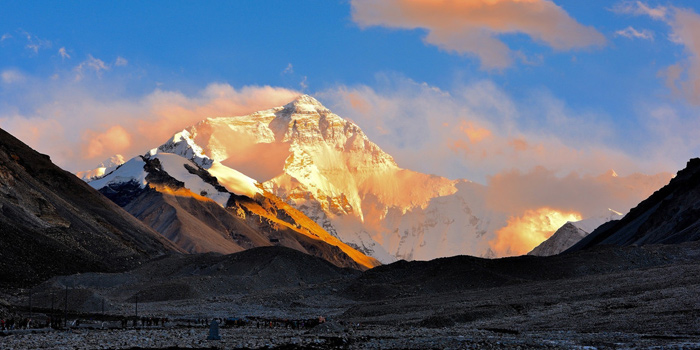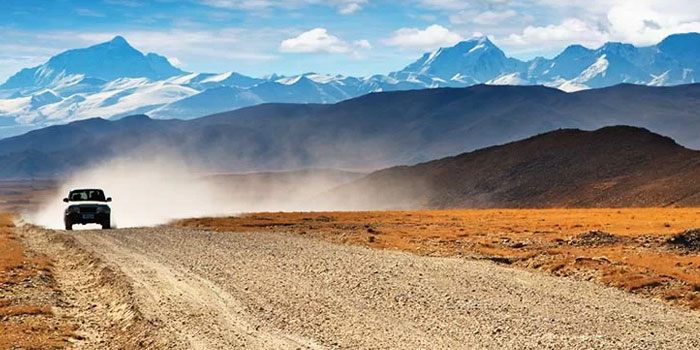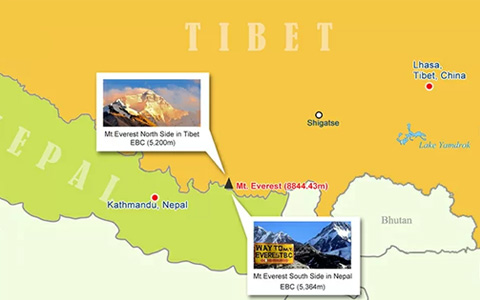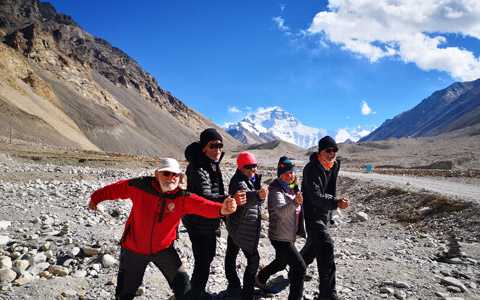How Many Base Camps on Everest in Both Sides of Tibet and Nepal
Mount Everest, also known as Sagarmatha in Nepali and Qomolangma in Tibetan, is the world’s highest mountain. Located on the border between China and Nepal, both the northern side and the southern side provide base camps for travelers and adventures to explore this landmark on Earth.
When discussing Mount Everest Base Camps, two primary base camps come to mind: the North Everest Base Camp in Tibet and the South Everest Base Camp in Nepal, both are popular spots for tourists.
But there's more to explore. Along the way to the summit, there are other base camps at different heights. These camps in Tibet and Nepal offer different perspectives and experiences for those interested in Mount Everest.
 1. (Tibetan Side) Northern Everest Base Camp is popular for Tibet Everest Tours
1. (Tibetan Side) Northern Everest Base Camp is popular for Tibet Everest Tours
 2. (Nepal Side) Southern Everest Base Camp is favored for Everest Trekking Tours in Nepal
2. (Nepal Side) Southern Everest Base Camp is favored for Everest Trekking Tours in Nepal
 3. Five Camps in Total for Climbing Mount Everest from the Northern Side (Tibet, China)
3. Five Camps in Total for Climbing Mount Everest from the Northern Side (Tibet, China)
 4. Five Camps in Total for Climbing Mount Everest from the Southern Side (Nepal)
4. Five Camps in Total for Climbing Mount Everest from the Southern Side (Nepal)
 5. How to plan an Everest Base Camp tour in Tibet?
5. How to plan an Everest Base Camp tour in Tibet?
 6. How to plan an Everest Base Camp tour in Nepal?
6. How to plan an Everest Base Camp tour in Nepal?
1. (Tibetan Side) Northern Everest Base Camp is popular for Tibet Everest Tours
On the northern side of the mountain, in the Tibet Autonomous Region of China, lies the northern base camp, at an altitude of 5,200 meters. Lying close to the Rongbuk Monastery, the base camp has been in use for almost 100 years and is a popular base camp for normal tourists as it does not require a great deal of trekking to reach it. In fact, there is no need to trek at all, as there is now an asphalt road that runs right up to Rongbuk Monastery.
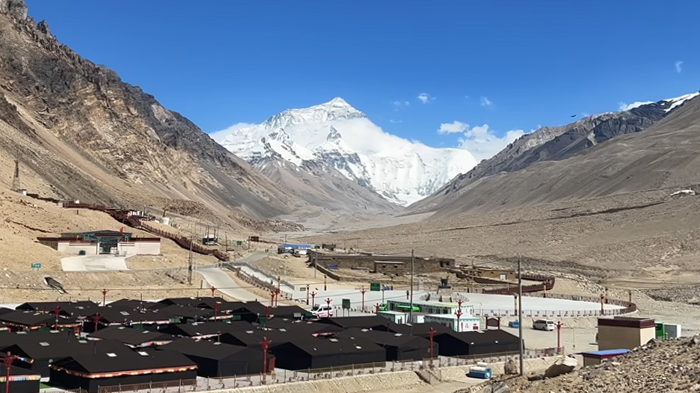 There are tent hotels at the Everest Base Camp in Tibet for numerous tourists from all over the world.
There are tent hotels at the Everest Base Camp in Tibet for numerous tourists from all over the world.
Of course, for adventure enthusiasts, there are more ways to get to the Northern Everest Base Camp in Tibet. The trekking from Old Tingri to Everest Base Camp in Tibet is popular among trekkers from all over the world. The route follows the Friendship Highway towards Cho Oyu Peak and then passes over Lamna La Pass. Motorcycle or cycling tours from Lhasa to EBC can also be booked.
Getting to the base camp in Tibet requires several permits that can only be arranged by a registered tour operator for Tibet, as well as requiring all tourists to be on an organized and pre-booked tour. As a prestigious EBC tour operator in Tibet, we can help you get all the travel documents, accommodation, and other fully escorted guide services for the Tibet Everest Base Camp Tour.
Regardless of which way you choose, planning your trip to the northern Base Camp during spring or autumn is highly recommended. Mid-April to early June and September to October are considered the best times to go. With less rainfall than during the summer, these months offer better visibility for viewing the summit of Mount Everest.
2. (Nepal Side) Southern Everest Base Camp is favored for Everest Trekking Tours in Nepal
Established in 1950, the South Everest Base Camp in Nepal is at an altitude of 5,364 meters and is the starting point of the climbing route used by Sir Edmund Hillary during the first successful summit in 1953.
The South Base Camp is 65 kilometers from Lukla with no direct road connection from Kathmandu. So the best way is to fly from Kathmandu to the small airport in Lukla first. It's a short 35-minute flight that costs around 180 USD, or 140 USD.
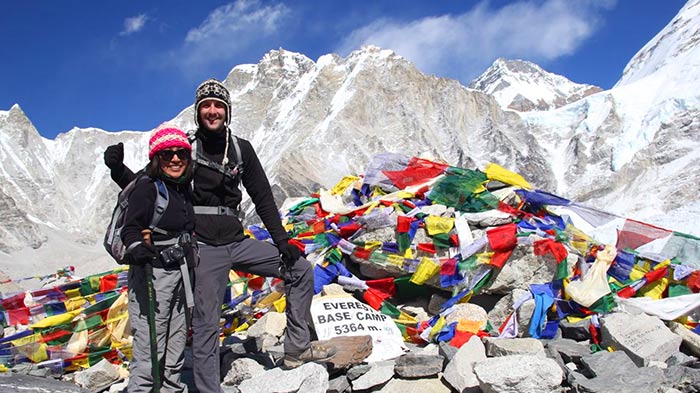 EBC in Nepal has been becoming the hottest destination
EBC in Nepal has been becoming the hottest destination
From Lukla, you can trek from Lukla to the South Base Camp. It takes 7-8 days to allow time for acclimatization. The return descent takes 3-4 days.
The other common route to from Jiri to the South Everest Base Camp. Jiri is a 7-hour bus ride from Kathmandu. The trek from Jiri takes 18-21 days, including stops for rest and acclimatization.
These Nepal Everest Base Camp trekking tours are some of the most popular routes in the world. The South Base Camp sees thousands of tourists every year. The large number of tourists has led to good facilities being available for travelers. Cozy teahouses can be found all along the trekking route, and Sherpas and Nepalis offer rentals of key equipment. You can even hire a porter to help carry your gear.
October to early December and April to May have the best conditions for trekking and mountaineering from the Everest Base Camp in Nepal as Nepal is more strongly affected by the monsoon season. Autumn skies in Nepal's Everest region are clear and blue. Spring has lots of sunshine and warm breezes.
3. Five Camps in Total for Climbing Mount Everest from the Northern Side (Tibet, China)
The lesser-known base camps are along the climbing routes to the summit of Mount Everest. They provide climbers with a chance to acclimatize and rest.
Ascending from Everest Base Camp in Tibet, the next camp is Advanced Base Camp at 6,500 meters. It's a 22km climb along Rongbuk glacier. The climb usually takes 2 days, stopping at an interim camp to rest.
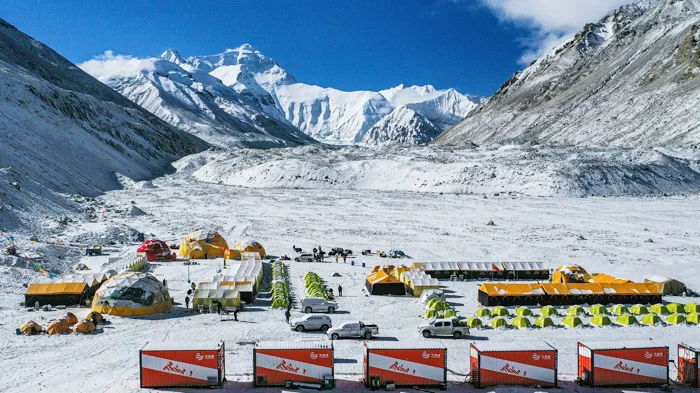 The Advanced Base Camp (ABC) on the Tibetan side of Mount Everest is at 6,500 meters above sea level.
The Advanced Base Camp (ABC) on the Tibetan side of Mount Everest is at 6,500 meters above sea level.
It's a 500m ascent from ABC to Camp 1 at 7,028 meters. A steep 60° section requires climbers to be clipped into a fixed rope. This climb takes 4-7 hours.
Camp 2 is the first of the 'High Camps'. It takes 3-5 hours to reach Camp 2 along a route that is mostly snow. At 7,790 meters, many climbing teams use this as the stop for acclimatization.
At 7,900 meters there is Camp 3, but some climbers pass straight to Camp 4. It takes 3-6 hours to reach Camp 3 along a very windy route. At this stage of the climb, almost all climbers sleep on supplemental oxygen.
Camp 4, at 8,300 meters, is a short rest stop on the way to the summit. It is not a place to stop for very long. Most climbers will have some food and water and then set out for the summit at 10 pm.
4. Five Camps in Total for Climbing Mount Everest from the Southern Side (Nepal)
Since opening in 1950, it has seen more climbers summiting Mount Everest from the Southern Everest Base Camp than from the North Base Camp. Some people consider the summit route on the south side easier than the north. Besides the Southern Everest Base Camp, there are another four camps on the Nepal side of Mount Everest.
Ascending the 600 meters from South EBC to Camp 1 at 5,980 meters takes 3-6 hours. The route for the first part over the moving glacier, Khumbu Ice Fall, changes every day.
It takes 2-3 hours to climb the 420 meters to Camp 2 at 6,400 meters. The route is heavily crevassed, and clipping it to the fixed rope is a good idea. It is only toward the end of this stage that climbers get their first view of the summit.
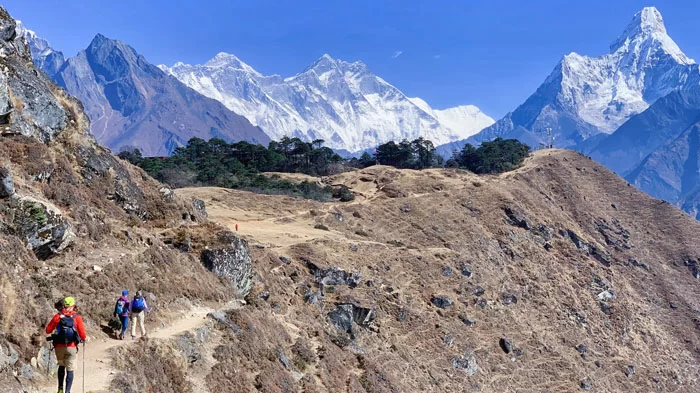 The trekking route the Camp 1 on the northern side of Mount Everest in Nepal
The trekking route the Camp 1 on the northern side of Mount Everest in Nepal
Camp 3 is 700 meters above Camp 2. The ascent takes 3-7 hours, and climbers need to be clipped to the fixed line at all times to reach 7,300 meters safely. Hard ice and a steep angle make crampon use difficult, and lines of climbers along the ropes can get backed up in busy seasons.
Camp 4, known as South 4, takes 3-6 hours. It's a relatively short 1.2km to ascend 700 meters, but climbing becomes difficult as you approach 8,000m. This is where most climbers start using bottled oxygen for the first time.
5. How to plan an Everest Base Camp tour in Tibet?
Planning an Everest Base Camp tour in Tibet is an exciting adventure, offering breathtaking views of the world's highest peak. The Lhasa to Everest Base Camp tour typically takes 8 days, starting from Lhasa and passing through stunning landscapes like Yamdrok Lake and Shigatse.
First, make sure you have the right required travel permits. Get your Chinese Visa from your country's embassy and let us handle the Tibet Travel Permit when you book your trip. Just send scanned copies of your documents to make things easy.
Stay healthy by preparing for altitude sickness. Talk to a doctor before you go to get advice and any necessary medication.
Pack smartly for the cold weather. Even if you visit the Everest Base Camp in summer, you need to bring warm clothes, sunscreen, and any personal medications you need. And don't forget a spare power bank to keep your devices charged.
With proper planning and preparation, your Everest Base Camp tour will be a memorable experience.
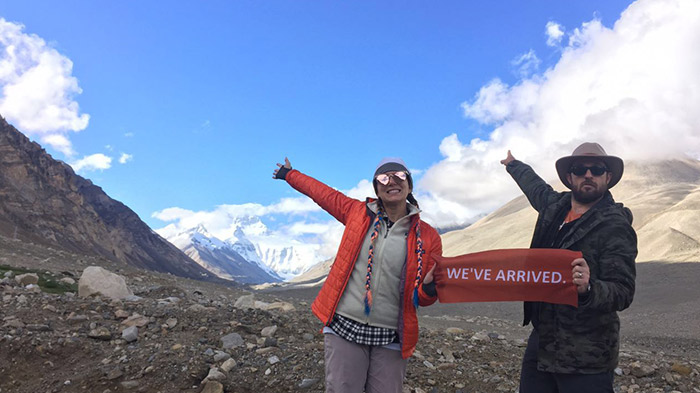 It could be a lifetime experience to visit the Everest Base Camp in Tibet.
It could be a lifetime experience to visit the Everest Base Camp in Tibet.
6. How to plan an Everest Base Camp tour in Nepal?
A trekking tour from Kathmandu to South Base Camp takes around 2 weeks. And Mount Everest climbing tours from the south side of Nepal could take more time. The schedule for the climbing days can vary depending on the weather and conditions of the climbing team.
Once you've decided on your itinerary, entering Nepal is easy. An online visa and visa on arrival are available for tourists entering Nepal. For touring South Base Camp, tourists either need a TIM card (Trekking Information Management System) or pay 2,000 Rs (~15 USD) to enter the Everest Region. There is also an entrance fee of 3,000 Rs (~22.5 USD) to enter Sagarmatha National Park, where EBC is located.
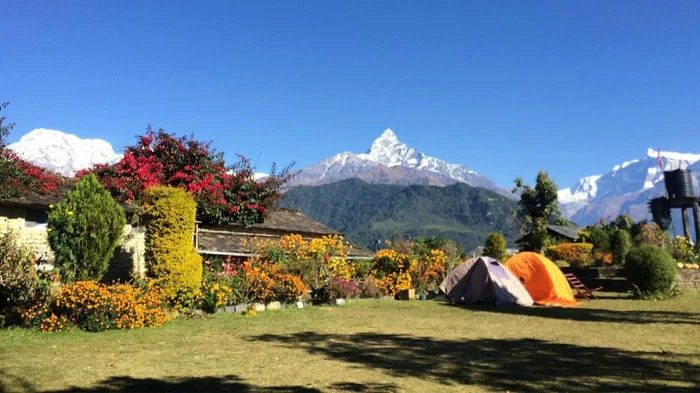 Visit Nepal Sagarmatha National Park to enjoy a different view of Mount Everest.
Visit Nepal Sagarmatha National Park to enjoy a different view of Mount Everest.
A fee is required to climb Mount Everest and tour the higher base camps. Currently, the fee is 11,000 USD, and it is scheduled to rise to 15,000 USD in 2025. The money raised through the fees will go toward maintaining the mountain and cleaning up things left behind by climbers.
Precautions for altitude sickness and preparations for packing are the same for both base camps.
7. More Interesting Facts about Base Camps on Mount Everest
The North Base Camp in Tibet was first set up in 1921 for the first attempt at a climb on the slopes of the mountain by British explorers George Mallory and Guy Bullock, reaching the upper slopes of the North Col. At the time, Nepal did not allow foreign entry to the kingdom, so the first forays into climbing the mountain had to be made from the Tibetan side.
Views of Mount Everest are different from both camps. From North Base Camp in Tibet, there is an unobstructed view of Mount Everest, including its dramatic peak. You can't see the mountain peak from South Base Camp in Nepal. Tourists travel to nearby Kala Patthar for the full view of Everest- Both main base camps have Wi-Fi, and connections are fast enough for video calls.
You can book a helicopter tour from Everest Base Camp in Nepal. The tour usually lasts 3-5 hours and gives amazing views of the Himalayas. Group flights can be booked for around 1,000 USD per person.
Conclusion
There are two main base camps on each side of Mount Everest: one in Tibet, China, and the other in Nepal. Both Everest Base Camps are accessible to ordinary tourists without requiring high-altitude mountain climbing experience. However, for a more adventurous experience, you would need to pass through additional camps to reach the summit of Mount Everest.
Whether you simply wish to witness the world's highest peak up close with an easy trip to the base camp or are planning to take on the challenge of trekking or climbing the mountain, we welcome you to share your travel ideas with us. We are committed to doing our best to help you make your dream come true.

The Lhasa-born prodigy used to study business overseas, and got his Bachelor of Business in Nepal and India before moving back to his homeland. With pure passion for life and unlimited love for Tibet, Kunga started his guide career as early as 1997.
Responsible, considerate, and humorous, he devoted his entire life to guiding and serving international tourists traveling in Tibet. As a legendary Tibetan travel guru with 20-year pro guide experience. Currently, he is working in Tibet Vista as the Tour Operating Director. Whenever our clients run into trouble, he is your first call and will offer prompt support.
Related Articles & Posts
Most Popular Tibet Tour Packages
-

Lhasa - Gyantse - Shigatse - Everest Base Camp - Shigatse - Lhasa
USD939
View Details -

Lhasa - Gyantse - Shigatse - E.B.C - Saga - Kailash Trek - Darchen - Lake Manasarovar - Saga - Gyirong - Tingri - Lhasa
USD2059
View Details -

10 Days Lhasa to Everest Base Camp and Namtso Lake Small Group Tour
Lhasa - Gyantse - Shigatse - EBC - Shigatse - Lhasa - Namtso Lake - Damxung - Lhasa
USD1289
View Details -

8 Days Driving Across Himalaya Overland Adventure from Kathmandu to Lhasa
Kathmandu - Gyirong - Everest Base Camp - Tingri - Shigatse - Gyantse - Lhasa
USD1069
View Details -

4 Days Lhasa Impression Small Group Tour: Explore the Heart of Tibet and Mingle with the Locals
Lhasa
USD509
View Details -

Lhasa - Gyantse - Shigatse - Everest Base Camp - Gyirong - Kathmandu
USD979
View Details -

Lhasa - Gyantse - Shigatse- Lhasa
USD799
View Details -

13 Day Lhasa, Mt. Everest, Mt. Kailash, Lake Manasarovar and Kathmandu Adventure Tour
Lhasa - Gyantse - Shigatse - EBC - Saga - Darchen - Kailash Trek - Darchen - Saga - Gyirong - Kathmandu
USD2059
View Details


.jpg)



